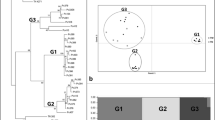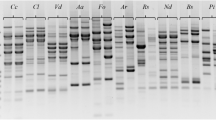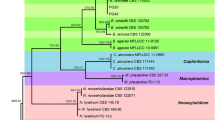Abstract
Phytophthora clandestina, a serious pathogen of subterranean clover (Trifolium subterraneum), has only been recorded in Australia. A rapid method was used to characterise genetic variation among 61 isolates of P. clandestina belonging to eight pathogenic races based on DNA sequencing and single-strand conformation polymorphism (SSCP) analyses of the β-tubulin gene of the pathogen. The β-tubulin gene among those tested displayed a high degree of variability among isolates. Cluster analysis of the SSCP profiles grouped the 61 isolates into two main clusters (A and B). ClusterAwith 3 subclusters viz; I (race 177), II (race 000) and III (races 001, 121, 101, 143 and 157) and B with race 173 alone. In addition, SSCP of β-tubulin also successfully differentiated between races 173 and 177, the two most prevalent and most virulent of the races studied. This is the first time that the β-tubulin gene has been used to study intra-species variation in this pathogen. In addition to showing relationship among the strains, it also provides a practical means for rapid monitoring of current and future differences in the distribution of P. clandestina strains, giving subterranean clover breeders and farmers a sound basis for the selection/breeding and deployment of appropriate cultivars to counter the predominant strain populations in specific localities.
Similar content being viewed by others
References
Barbetti MJ, You MP, Li H, Ma X, Sivasithamparam K (2007) Management of root diseases of annual pasture legumes in Mediterranean ecosystems — a case study of subterranean clover root diseases in the south-west of Western Australia. Phytopathologia Mediterranea 46, 239–258.
Bhat RG, Schmitthenner AF (1993) Genetic crosses between physiologic races of Phytophthora sojae. Experimental Mycology 17, 122–129. doi: 10.1006/emyc.1993.1011
Bhat RG, Colowit PM, Tai TH, Aradhya MK, Browne GT (2006) Genetic and pathogenic variation in Phytophthora cactorum affecting fruit and nut crops in California. Plant Disease 90, 161–169. doi: 10.1094/PD-90-0161
Bielenin A, Jeffers SN, Wilcox WF, Jones AL (1988) Separation by protein electrophoresis of six species of Phytophthora associated with deciduous fruit crops. Phytopathology 78, 1402–1408. doi: 10.1094/Phyto-78-1402
Bilodeau GJ, Levesque CA, de Cock AWAM, Duchaine C, Briere S (2007)Molecular detection of Phytophthora ramorum by real-time polymerase chain reaction using TaqMan, SYBR Green, and molecular beacons. Phytopathology 97, 632–642. doi: 10.1094/PHYTO-97-5-0632
Camele I, Marcone C, Cristinzio G (2005) Detection and identification of Phytophthora species in southern Italy by RFLP and sequence analysis of PCR-amplified nuclear ribosomal DNA. European Journal of Plant Pathology 113, 1–14. doi: 10.1007/s10658-005-8915-1
Cooke DEL, Drenth A, Duncan JM, Wagels G, Brasier CM (2000) A molecular phylogeny of Phytophthora and related Oomycetes. Fungal Genetics and Biology 30, 17–32. doi: 10.1006/fgbi.2000.1202
Crespo A, Molina MC, Blanco O, Schroeter B, Sancho LG, Hawksworth DL (2002) rDNA ITS and β-tubulin Gene sequence analyses reveal two monophyletic groups within the cosmopolitan lichen Parmelia saxatilis. Mycological Research 106, 788–795. doi: 10.1017/S095375620200 610X
Forster H, Tyler BH, Coffey MD (1994) Phytophthora sojae races have arisen by clonal evolution and by rare outcrosses. Molecular Plant-Microbe Interactions 7, 780–791.
Forster H, Cummings MP, Coffey MD (2000) Phylogenetic relationships of Phytophthora species based on ribosomal ITS I DNA sequence analysis with emphasis on Waterhouse groups V and VI. Mycological Research 104, 1055–1061. doi: 10.1017/S0953756200003087
Gladstones JS (1975) Legumes and Australian agriculture. Journal of the Australian Institute of Agricultural Science 41, 227–240.
Gladstones JS, Collins WJ (1983) Subterranean clover as a naturalized plant in Australia. Journal of the Australian Institute of Agricultural Science 49, 191–202.
Goldman GH, Temmerman W, Jacobs D, Contreras R, Van Montagu M, Herrera-Estrella A (1993) A nucleotide substitution in one of the beta-tubulin genes of Trichoderma viride confers resistance to the antimitotic drug methyl benzimidazole-2-yl-carbamate. Molecular & General Genetics 240, 73–80. doi: 10.1007/BF00276886
Irzykowska L, Irzykowski W, Jarosz A, Golebniak B (2005) Association of Phytophthora citricola with leather rot disease of strawberry. Journal of Phytopathology 153, 680–685. doi: 10.1111/j.1439-0434.2005.01037.x
Ivors KL, Hayden KJ, Bonants PJM, Rizzo DM, Garbelotto M (2004) AFLP and phylogenetic analyses of North American and European populations of Phytophthora ramorum. Mycological Research 108, 378–392. doi: 10.1017/S0953756204009827
Kim K-J, Eom S-H, Lee S-P, Jung H-S, Kamoun S, Lee YS (2005) A genetic marker associated with the A1 mating type locus in Phytophthora infestans. Journal of Microbiology and Biotechnology 15, 502–509.
Kong P, Hong C, Richardson PA, Callegly ME (2003a) Single-strand-conformation polymorphism of ribosomal DNA for rapid species differentiation in genus Phytophthora. Fungal Genetics and Biology 39, 238–249. doi: 10.1016/S1087-1845(03)00052-5
Kong P, Hong C, Richardson PA (2003b) Rapid detection of Phytophthora cinnamomi using PCR with primers derived from the Lpv putative storage protein genes. Plant Pathology 52, 681–693. doi: 10.1111/j.1365-3059.2003.00935.x
Kong P, ba]Hong CX, Tooley PW, Ivors K, Garbelotto M, Richardson PA (2004) Rapid identification of Phytophthora ramorum using PCR-SSCP analysis of ribosomal DNA ITS-1. Letters in Applied Microbiology 38, 433–439. doi: 10.1111/j.1472-765X.2004.01510.x
Kroon LPNM, Bakker FT, van den Bosch GBM, Bonants PJM, Flier WG (2004) Phylogenetic analysis of Phytophthora species based on mitochondrial and nuclear DNA sequences. Fungal Genetics and Biology 41, 766–782. doi: 10.1016/j.fgb.2004.03.007
Ma Z, Michailides TJ (2005) Advances in understanding molecular mechanisms of fungicide resistance and molecular detection of resistant genotypes in phytopathogenic fungi. Crop Protection (Guildford, Surrey) 24, 853–863. doi: 10.1016/j.cropro.2005.01.011
May GS, Tsang MLS, Smith H, Fidel S, Morris NR (1987) Aspergillus nidulans beta tubulin genes are unusually divergent. Gene 55, 231–243. doi: 10.1016/0378-1119(87)90283-6
McHau GRA, Coffey MD (1994) Isozyme diversity in Phytophthora palmivora: evidence for a southeast Asian centre of origin. Mycological Research 98, 1035–1043. doi: 10.1016/S0953-7562(09) 80430-9
Mirabolfathy M, Alizadeh A, Rahimian H (2000) Morphological, physiological and isozymic comparison of Phytophthora megasperma from pistachio and other hosts. Iranian Journal of Plant Pathology 36, 15–20.
Morley FHW (1961) Subterranean clover. Advances in Agronomy 13, 57–123. doi: 10.1016/S0065-2113(08)60957-8
Orita M, Iwahana H, Kanazawa H, Hayashi K, Sekiya T (1989) Detection of polymorphism of human DNA by gel electrophoresis as single-strand conformation polymorphisms. Proceedings of the National Academy of Sciences of the United States of America 86, 2766–2770. doi: 10.1073/pnas.86.8.2766
Panaccione DG, Hanau RM (1990) Characterization of two divergent beta tubulin genes from Colletotrichum graminicola. Gene 86, 163–170. doi: 10.1016/0378-1119(90)90275-V
Pane A, Agosteo GE, Cacciola SO (2000) Phytophthora species causing crown and root rot of tomato in southern Italy. Bulletin OEPP. EPPO Bulletin. European and Mediterranean Plant Protection Organisation 30, 251–255. doi: 10.1111/j.1365-2338.2000.tb00890.x
Powell SC (1970) Subterranean clover, our most important pasture legume. Journal of Agriculture, Victoria 68, 274–277.
Purwantara A, Flett SP, Keane PJ (1996) Resistance of nineteen cultivars of subterranean clover to four races of Phytophthora clandestina. Euphytica 91, 351–358. doi: 10.1007/BF00033097
Purwantara A, Flett SP, Keane PJ (1998) Variation in pathogenicity among isolates of Phytophthora clandestina. Journal of Phytopathology 146, 587–591. doi: 10.1111/j.1439-0434.1998.tb04759.x
Purwantara A, Drenth A, Flett SP, Guppy W, Keane PG (2001) Diversity of Phytophthora clandestina isolated from subterranean clover in southern Australia: analysis of virulence and RAPD profiles. European Journal of Plant Pathology 107, 305–311. doi: 10.1023/A:1011272419130
Ryley MJ, Obst NR (1998) Changes in the racial composition of Phytophthora sojae in Australia between 1979 and 1996. Plant Disease 82, 1048–1054. doi: 10.1094/PDIS.1998.82.9.1048
Ryley MJ, Obst NR, Stovold GE (1991) A new race of Phytophthora megasperma f. sp. glycinea on soybean in Australia. Australasian Plant Pathology 20, 97–100. doi: 10.1071/APP9910097
Saitou N, Nei M (1987) The neighbor-joining method: a new method for reconstructing phylogenetic trees. Molecular Biology and Evolution 4, 406–425.
Sandral GA, Dear BS, Brennan J, Ewing MA (1997) The economic value of investment in annual plant improvement for cropping systems of Australia. Report to the Grains Research and Development Corporation, Canberra, Australia.
Sekiya TMY, Hayashi K (1993) Detection of mutant sequences by single-strand conformation polymorphism analysis. Mutation Research 288, 79–83. doi: 10.1016/0027-5107(93)90209-X
Slabaugh MB, Huestis GM, Leonard J, Holloway JL, Rosato C (1997) Sequence-based genetic markers for genes and gene families: single-strand conformational polymorphisms for the fatty acid synthesis genes of Cuphea. Theoretical and Applied Genetics 94, 400–408. doi: 10.1007/s001220050429
Sullivan KF (1988) Structure and utilization of tubulin isotypes. Annual Review of Cell Biology 4, 687–716. doi: 10.1146/annurev.cb.04.110188.003351
Swofford K (2002) ‘PAUP*: Phylogenetic Analysis Using Parsimony and other methods.’ (Sinauer Associates: Sunderland, MA)
Taylor PA, Greenhalgh FC (1987) Significance, causes and control of root rots of subterranean clover. In ‘Temperate pastures: their production, use and management.’ (Eds JL Wheeler, CJ Pearson, GE Robards) pp. 249–251. (Australian Wool Corporation/Commonwealth Scientific and Industrial Research Organisation: Melbourne)
Taylor PA, Pascoe IG, Greenhalgh FC (1985) Phytophthora clandestina new-species in roots of subterranean clover. Mycotaxon 22, 77–86.
Thompson JD, Higgins DG, Gibson TJ (1994) CLUSTAL W: improving the sensitivity of progressive multiple sequence alignment through sequence weighting, position-specific gap penalties and weight matrix choice. Nucleic Acids Research 22, 4673–4680. doi: 10.1093/nar/22.22.4673
Voigt K, Cozijnsen AJ, Kroymann J, Pöggeler S, Howlett BJ (2005) Phylogenetic relationships between members of the crucifer pathogenic Leptosphaeria maculans species complex as shown by mating type (MAT1-2), actin, and β-tubulin sequences. Molecular Phylogenetics and Evolution 37, 541–557. doi: 10.1016/j.ympev.2005.07.006
Walker AK, Schmitthenner AF (1984) Comparison of field and greenhouse evaluations for tolerance to Phytophthora rot in soybean. Crop Science 24, 487–489.
Weerakoon ND, Roberts JK, Lehnen LP Jr, Wilkinson JM, Marshall JS, Hardham AR (1998) Isolation and characterization of the single beta-tubulin gene in Phytophthora cinnamomi. Mycologia 90, 85–95. doi: 10.2307/3761016
White TJ, Bruns Y, Lee S, Taylor J (1990) Amplification and direct sequencing of fungal RNA genes for phylogenetics. In ‘PCR protocols: a guide to methods and applications.’ (Eds M Innis, D Gelfand, J Sninsky, I White) pp. 315–322. (Academic Press: San Diego, CA)
Yamak F, Peever TL, Grove GG, Boal RJ (2002) Occurrence and identification of Phytophthora spp. pathogenic to pear fruit in irrigation water in the Wenatchee River Valley of Washington State. Phytopathology 92, 1210–1217. doi: 10.1094/PHYTO.2002.92.11.1210
You MP, Barbetti MJ, Nichols PGH (2005a) New sources of resistance in Trifolium subterraneum L. to root rot caused by two races of Phytophthora clandestina Taylor, Pascoe and Greenhalgh. Australian Journal of Agricultural Research 56, 271–277. doi: 10.1071/AR04293
You MP, Barbetti MJ, Sivasithamparam K (2005b) Characterization of Phytophthora clandestina races on Trifolium subterraneum in Western Australia. European Journal of Plant Pathology 113, 267–274. doi: 10.1007/s10658-005-1226-8
You MP, Barbetti MJ, Sivasithamparam K (2006) Occurrence of Phytophthora clandestina races across rainfall zones in south-west Western Australia. Australasian Plant Pathology 35, 85–87. doi: 10.1071/AP05090
Author information
Authors and Affiliations
Rights and permissions
About this article
Cite this article
Ma, X.L., Kong, P., You, M.P. et al. Molecular variation among isolates belonging to eight races of Phytophthora clandestina . Australasian Plant Pathology 38, 608–616 (2009). https://doi.org/10.1071/AP09047
Received:
Accepted:
Issue Date:
DOI: https://doi.org/10.1071/AP09047




